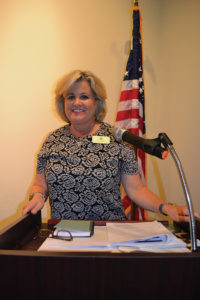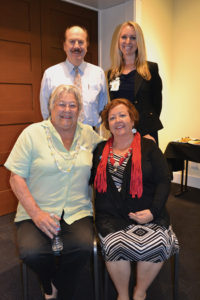Part of the fun of wealth is giving it away!
By Kris Grant
This is the perfect time to think about philanthropy — after all, it’s the season of giving and charitable giving often gives you a little bonus in the form of a year-end tax deduction.
But maybe a more strategic giving plan would make better sense for you, your family and other designated heirs, as well as the charities you wish to support. Planned giving was the subject of a recent seminar on philanthropy hosted by Plan to Prosper, a financial planning firm.The seminar was moderated by Plan to Prosper’s Jane Braun, a certified financial planner.
Braun noted the No. 1 category of those giving to charity today is not corporations, but individuals and families. “As families accumulate wealth, they ask themselves, ‘What should we do with our money?’”
Braun kicked off the session by sharing that she has a “deep passion for philanthropy.”
“Philanthropy is a way we can support our community and support the next generation,” she said. “I think of it as building a better world for tomorrow.”
She noted that Coronado is a bit of a microcosm, a world in miniature. “We live, play and celebrate here together,” she said. “And so I have this dream that we could one day have a Coronado Foundation, like the San Diego Foundation, that could support the good work that supports our community.”
Currently serving as president of Coronado Historical Association and a board member of Rotary Club of Coronado, Braun is already investigating the steps to form a local foundation. In the meantime, she invited local organizations to share their missions and financial needs, followed by a panel of financial professionals who discussed smart strategies in planned giving The organizations presenting were the Coronado Schools Foundation, Coronado Public Library, Coronado Historical Association and Coronado Hospital Foundation.
Coronado Schools Foundation
Patty Cowan is in her fifteenth year as chief executive officer of Coronado Schools Foundation, which supports academics and technology in the classrooms of all Coronado public schools.
Cowan noted that when the state passed a new local control funding formula in 2013, it put Coronado Unified School District in the lowest funding tier, based on the district’s corresponding numbers of low socio-economic level students, homeless and foster children and English-as-a-second-language learners. “If we were part of the San Diego Unified School District, we would receive $1,900 per student more from the state,” she said. “It represents about a $6 million funding gap.”
She said one goal is to raise the foundation’s endowment fund from its current $6 million to $10 million, allowing 4 percent to be returned annually to schools while protecting the principle. In addition to its major fundraisers (a fall gala/auction and spring telethon), “one of the things that was life-changing was in 2010 when we received a $4 million grant from Frances Harpst,” Cowan said. “It provided a base to provide consistent funding to our schools.”
The foundation funds such programs as science and computer labs in kindergarten to fifth grade and introduction to engineering, computer science and coding classes for middle and high school students. As a result, Coronado High School now has a compact with San Diego State University for engineering students.
Coronado Public Library
Anyone can come in and use the facilities of the Coronado Public Library free of charge, noted Christian Esquevin, who has served as the city’s director of library services since 1988. “You need to register if you want a library card but you can come in, sit and read, use free wireless, plug in your laptop, enjoy the art and atmosphere, and access databases. We have all kinds of information that is quite astonishing through the digital frontier.”
Esquevin noted that the library is supported by the city, which pays its bills, staff, and utilities. But the library began in 1890 as a private non-public-supported entity, an offshoot of the Presbyterian Church. Then Elisha Babcock, one of the first investors and the first manager of the Hotel del Coronado, and his wife became its first patrons. John D. Spreckels, after purchasing the Del, held many fundraisers at the hotel. “They even had the secretary of the Del arrange for its guests to support the library,” Esquevin noted. Spreckels and Babcock made a rent-free arrangement for the old pavilion (now the site of the Glorietta Bay Inn) to become the Coronado Beach Library from 1895 through 1909. In 1909, Spreckels paid for the land, design by his architect Harrison Albright and the construction of the first library at its current location in the 600 block of Orange Avenue. “But from then on, the city of Coronado paid the library’s basic functions; donors who left bequests have been a big level of support,” Esquevin said.
One example of a major donation that Esquevin cited was from the estate of Judith Bond, who worked as one of the archivists at the Hotel Del. It allowed for digitizing all the Coronado newspapers from 1887 to 2012. Patrons can now access the fully indexed papers from their home or office via the Internet. “You can see the full pages, just as they were,” Esquevin said.
The restoration and installation costs of the Alfredo Ramos Martinez murals were made possible by a bequest from June Muller, a journalist with the Coronado Eagle newspaper. “Even though the library is a municipal department you can make a big difference for us and help the community and its heritage,” Esquevin concluded. “Donations can be made through the Friends of the Coronado Public Library, a 501 (c) (3) or directly to the library, which, as a municipal entity, is also tax-exempt.”
Coronado Historical Association
Susan Keith, a board member of Coronado Historical Association, said that this Coronado nonprofit lies closest to her heart — and not just because her mother, Eleanor Ring Storrs, signed the association’s articles of incorporation in 1969.
“We’re really all about saving the family histories of those who made Coronado home. Our memories are our history,” Keith told seminar attendees. “We want the family histories of people who have recently come to Coronado, and we want the histories of those who were born and raised here. It’s amazing how the kids love to hear about the old stories.”
Philanthropy makes the work of the association possible, Keith said. As one example, Don and Leslie Budinger are gifting the building where the association is located, the former Bank of Commerce, to the historical group over a number of years. “We house our archives in the vaults of the former bank that stood on this corner. The archives are well protected, and we can control the humidity and temperature,” Keith said.
Among the association’s archives are approximately 20,000 photographs; 20,000 documents and about 3,000 objects, referred to as “3Ds.” “One of the problems with 3Ds is you cannot pile them on top of each other. We need to purchase more archival boxes and they are expensive,” Keith said.
The association research library is available to the public free of charge, with nominal charges for copies.
The historical association operates the Coronado Museum of History and Art, which is seeking national accreditation through an intensive three-year process. “Accreditation shows the world and our citizens that we are using the best possible processes for saving our history,” Keith said. “Education is a major part of our day-to-day work; we work with third graders, and we are expanding to middle school and high school. We want to have scholarships and internships so that people can learn how to do museum work.”
Keith said that a Coronado resident, the late Mary Gayle-Buchanan, left a condominium to the historical association in her estate plan. “It was quite a surprise,” Keith said. “We received close to a million dollars when her estate was settled, which we have put in a savings account. Those funds will be used to help us with accreditation.”
Coronado Hospital Foundation
Nora Boswell has been in her role as chief development officer at the Coronado Hospital Foundation for six years, and notes that the hospital was built “for the community, by the community.”
“John D. Spreckels donated land in 1938 for the hospital at its current location on Soledad Place. In the late 1960s, as the city’s population grew, the hospital board decided they needed to expand and built the present four-story building. They were a bit short of funds until a hospital volunteer requested a family member donate $2.3 million in Coca-Cola stock. That gift allowed the hospital to open its new doors, debt free. That volunteer also started the hospital’s Meals on Wheels program and when she passed in 2010, she left us a wonderful estate gift. And, yes, it was Frances Harpst; her daughter continues to volunteer with us and give back to this community,” Boswell said.
“The No. 1 reason people give to us is to make sure that there is a hospital on this island,” Boswell said. “They don’t want to get caught in the traffic when the Navy gets off and they can’t get across the bridge when they have a medical emergency.”
Boswell noted that Sharp Coronado was the first hospital in San Diego County to do partial joint replacements using robotic surgery and that it continues to focus on the needs of the community.
The $12.5 million Payne Family Outpatient Pavilion, which will open in summer 2018, was funded by hundreds of community members including leaders such as Bob and Patty Payne, with two-to-one matching funds by the city of Coronado.
“Funding the Payne Family Outpatient Pavilion was a huge undertaking,” said Boswell. “To put it into perspective, the entire four-story hospital was built at a cost of $4.2 million.”
The panel of estate-planning strategists included Norm Timmons, who began Sharp Healthcare Foundation’s planned giving programs and four Coronado residents well-versed in planning giving: Michael Manning of Manning Wealth Management, estate planning attorneys Margaret “Tami” Sandke and Pat Callahan, and Dan Gensler, founder and president of the wealth management firm, The Gensler Group.
Panelists discussed the pros and cons of donor-advised funds, charitable lead trusts, designating funds from IRAs rather than savings to mitigate taxable events for heirs, charitable lead trusts, family foundations, and charitable gift annuities that offer individuals the security of knowing what their monthly income will be for the rest of their lives while allowing them to support causes that touch them most deeply. Some take-aways included:
Sandke advised she wouldn’t recommend a charitable remainder trust for an estate less than $100,000. “You need an attorney to create it; and tax returns filed on it,” she said. “Most of my clients look at it when they reach about a $500,000 threshold. There are many other ways to give; the donor-advised fund is usually the best vehicle for smaller gifts.”
Manning recommended, “Let’s look at your IRAs for your charities; then the remainder can go to your children. Your children will have the income tax benefit.”
Some families consider setting up a private foundation, but Manning noted, “What comes with private foundations is complexity, and although it sounds fun and fancy to have a family foundation, we’re seeing people shut them down and transfer the moneys into donor-advised funds. It makes it real easy for themselves in the future. Family foundations should not be +considered for estates under $10 million to $20 million.”
And when the question arises of how much to leave to your children, Callahan refers to the sage advice of Warren Buffett. “Leave enough to your children so they can do anything they want to do but not so much that they can do nothing.”



![]()

